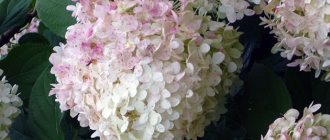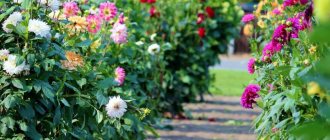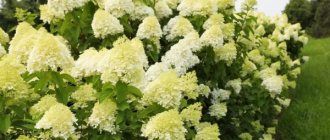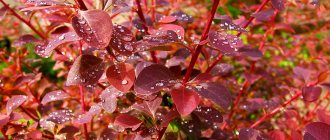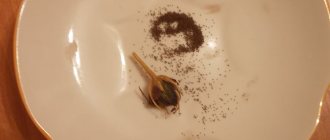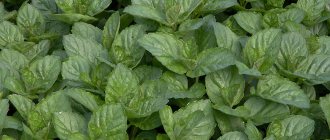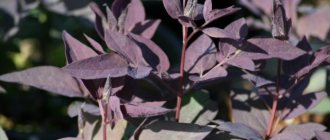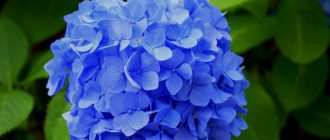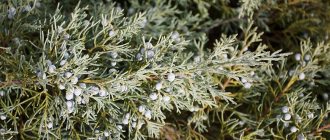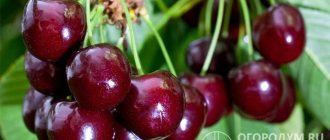Don't know how to decorate your site? Plant the best varieties of paniculata hydrangea. These luxurious plants with a huge number of beautiful varieties will not leave anyone indifferent. Gorgeous paniculate inflorescences up to 25 cm long in the shape of a wide pyramid consist of small and large flowers.
The main feature of flowering hydrangea is its ability to gradually change its color depending on the composition of the soil.
For your attention – our Top 15 beautiful varieties of paniculate hydrangea, which will feel great in the middle zone, for example, in the Moscow region. Photos and descriptions of varieties are accompanied by tips on care and recommendations for growing.
Bobo
The dwarf variety Bobo received the “Best Variety” award at a flower exhibition in Belgium in 2011. During the abundant and long flowering of this hydrangea, the color of its petals changes from white-yellow to soft pink.
Due to its low growth, Bobo hydrangea is suitable for growing in containers that can be placed on a balcony or summer terrace. It is advisable that this be a semi-shaded place, since in the bright sun the hydrangea inflorescences become smaller. It is important that the bush is protected from gusty winds.
| Purpose | Bush height (cm) | Bush width (cm) | Flowering period | Peculiarities |
| 70 | 50 | From July to September | Plant winter-hardy, but the roots young bushes needed for winter mulch | |
High varieties of tree-like Hydrangea paniculata
These varieties are more suitable for medium and large garden and summer cottage plots. The average height of shrubs can reach 2.5 – 3 meters. We will describe the most popular varieties among domestic flower growers.
Hydrangea paniculata Unique
This variety was developed in Belgium in 1950. In adulthood it reaches a height of up to 3 meters. Often this variety is formed into a tree-like form.
A fast-growing plant, it blooms white sterile flowers from June to the end of September. Towards the end of flowering, the inflorescences change their color to pink.
Hydrangea paniculata variety White Goliath
Shrub with large flowers. At the age of 10 it reaches 4 m in height. The flowers are white. Completely winter-hardy plant.
Flowering period June - August. As they mature, the sepals droop down, changing their color to dull pink.
Hydrangea paniculata Levana
This is a giant among paniculate Hydrangeas. In adulthood it can reach 5 meters in height. The plant produces long, strong stems with conical inflorescences up to 50 cm long, consisting of creamy white inflorescences on long peduncles.
The flowers have long petals. The leaves are medium green, broadly ovate, slightly serrated. Flowering period August – October.
This shrub is best pruned every spring to encourage strong new growth with huge flowers.
Hydrangea paniculata variety Grandiflora (Hydrangea paniculata Grandiflora)
'Grandiflora', imported from Japan in the 1860s, makes an excellent hedge subject. It is a large erect deciduous bush or small tree (up to 4.5 m high) with conical flower panicles 45 cm long, almost completely filled with sterile flowers.
The showy, creamy white inflorescences turn pink as autumn approaches. Blooms profusely from mid-summer to autumn.
You might be interested
The best perennial bush flowers for the garden: features and selection rules
A Complete Guide to Growing Hydrangea Paniculata
Growing Hydrangea in the garden
Phantom
The variety is highly valued for its lush flowering and the unique honey aroma that the beautiful flowers emit. In summer, the inflorescences are light cream, and by autumn they become pinkish, while their tops turn yellow. The petals of this plant are slightly different from other hydrangeas: they are slightly elongated and are not located so closely to each other.
| Purpose | Bush height (cm) | Bush width (cm) | Flowering period | Peculiarities |
| 200 | 200 | From July to September | In the middle lane young plants may freeze so their cover layer of mulch | |
Which Hydrangea paniculata to choose: list of the best varieties with photos and descriptions
The diversity of this species is enormous. On the market you can find a large number of varieties with different bush sizes, hardiness, flower color and other characteristics. There are whole series of varieties of ornamental crops with similar characteristics that can be identified by name - for example, Pink, Magical, Vanille and others.
From this large number of varieties, we will introduce you to the old and new, the largest and dwarf, colorful and most beautiful varieties of flowering shrubs with photos and descriptions.
Garden novelties and rarities
Hydrangea paniculata variety Pastel Green
SUPER compact and still VERY rare (2016) variety.
Flowers can be light green, white, pink and raspberry pink.
Hydrangea paniculata variety Pastel Green
Hydrangea paniculata variety Magical Vesuvio, Magical Vesuvio
A new and still rare variety with a beautiful bush shape (up to 1.5 m in height). Large inflorescences are white when in bloom, then turn pink and become burgundy by autumn.
Hydrangea paniculata variety Magical Vesuvio (photo Agroholding SEARCH)
Hydrangea paniculata variety White Light, Whitelight
Awarded a gold medal at the Plantarium 2019 exhibition (Holland).
A compact, low (up to 1 m) bush grows easily and branches well. The dark green leaves contrast beautifully with the white flowers. The flowers are initially lemon-colored, then turn creamy and eventually white. In autumn they turn pink.
Ideal for use on terraces, patios, balconies.
Hydrangea paniculata variety White Light, Whitelight (photo Agroholding SEARCH)
Hydrangea paniculata variety Samme Snow, Summer Snow
NEW 2019
A dense, low bush with strong straight shoots, has a neat appearance and does not fall apart. The inflorescences of sterile flowers are very large. The flowers are white and do not change color throughout the season.
Hydrangea paniculata variety Samme Snow, Summer Snow (photo Agroholding SEARCH)
Hydrangea paniculata variety Samara Lydia>>>
Reproduction
The first method is cuttings.
- Cut a branch of hydrangea with two or three pairs of leaves. It should end right under the last pair (knot). These two leaves need to be cut to the very base of the petioles, and the rest of the leaves should be cut off in half plates.
- Such a cutting is immersed in the Epin solution for 12 hours.
- The lower node is powdered with Kornevin. Then stick the cutting into sand or other substrate at an angle of 45℃. Cover with a bag and put in the shade.
- After a month, roots appear, then the cutting can be transplanted into a pot with soil mixture. A three- to four-year-old seedling is planted in open ground.
But the method is labor-intensive, so hydrangeas are often propagated by layering or dividing the bush. Layering is generally elementary.
- Bend the lower shoot to the ground and cover with soil.
- Care for it in the same way as for the mother bush, cover it for the winter.
- In the spring you can cut it off and plant it.
How to divide the root?
- In the spring, remove the bush from the ground as for replanting. Examine its root system, find the buds. Based on their number, the hydrangea can be divided into two, three or more parts.
- Cut the root, divide the plant. The wounds can be sprinkled with charcoal or smeared with a solution of brilliant green.
- Plant each part in a separate hole.
Regardless of the method, all seedlings must be protected not only from frost, but also from sunlight. Unlike adult panicle hydrangea, which grows in the sun, a young plant will get sick from direct ultraviolet rays.
Hydrangea paniculata
How to plant a plant correctly
Optimal conditions for paniculata hydrangea:
- Light partial shade. Ideally, the sun illuminates the plant in the morning or late afternoon. Under direct rays, flowers lose the ability to change shades, the petals fade. In dense shade the bush develops slowly and blooms sparingly.
- Acidic substrate. In such soil the plant blooms brightest and most magnificently. At the same time, it should be quite nutritious - loam or red soil will do. The plant is moisture-loving; it will take root even in wetlands. Sandy, calcareous soil, as well as neutral and alkaline substrates are not suitable for hydrangeas (chlorosis develops).
- Groundwater close to the soil surface (1–1.5 m). This is not a prerequisite, but will reduce the number of waterings. A bush with an actively expanding root system requires soil moisture within a radius of about 1.5 m.
Hydrangea paniculata needs sun, but it does not like prolonged exposure to direct rays
It is best to plant hydrangea in the spring (April-early May), although in the southern regions autumn planting is also acceptable (until mid-October). 4-5 year old seedlings adapt best and fastest to a new location. They should have a developed root system of flexible roots without traces of mold and rot and at least 2-3 shoots about 0.5 m long.
High-quality planting material in the case of paniculata hydrangea is the key to abundant flowering
The dimensions of the planting pit are about 0.5 m in diameter and 0.5–0.8 m in depth. The intervals between hydrangeas when planting two or more specimens at the same time depend on the variety. Usually 1.5–2.5 m is enough. The pit is filled with a mixture of high fertile turf, peat chips, coarse sand and soil from under coniferous trees (it consists of completely and partially rotted needles and cones), taken in a 2:2 ratio: 1:2. Fertilizers are also added - 65 g of simple superphosphate and 25 g of urea and potassium sulfate.
The landing itself goes like this:
- In the evening before planting, pour 30–40 liters of water into the planting hole.
- In the morning, form a mound from moist soil at the bottom.
- Trim dried and dead roots to living tissue, shorten healthy ones by 2–3 cm. Leave 3–5 growth buds on each shoot.
- Soak the roots in a solution of any biostimulant for a couple of hours.
- Place the seedling in the hole, spread the roots along the “slopes” of the mound, especially those that stick up and to the sides. Add soil in small portions, periodically compacting it with your palms. The root collar should eventually be 2-3 cm above the ground.
- Water the plant with 10–15 liters of water. After letting it soak in, mulch the tree trunk circle with pine needles, sawdust or pieces of coniferous tree bark, or peat chips.
Planting paniculata hydrangea will not be difficult even for novice gardeners
Video: planting hydrangea in open ground
Hydrangea paniculata tolerates replanting, in principle, normally, but sometimes the ability to move a shrub to a new place is limited by its size. The plant needs to be dug in a circle with a diameter approximately 1.5 times larger than the crown to a depth of 40–50 cm, together with a lump of earth, transferred on a sheet of plywood, a piece of burlap, dense polyethylene to the desired location and planted in a prepared hole. In the first month after transplantation, hydrangea needs more abundant watering than usual (as the top layer of soil dries) and shading from the sun. After this period, feed the bush.
Transplanting paniculate hydrangea is possible as long as the dimensions of the bush allow it
